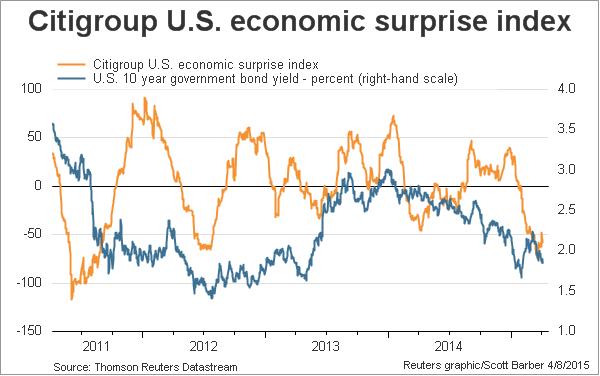Lingering concerns keep the Fed on hold
On Wednesday, the release of the Federal Reserve's latest policy minutes shed some light into the rationale for last month's surprise. Back on March 18 during its last policy-setting meeting, the Fed opened the door to a rate hike as soon as June, but the policy-makers also unexpectedly halved their estimate of the number of interest rate hikes the Fed expects this year to just two.
The reason is lingering concerns about the risks foreign developments -- from a slowdown in China to an unresolved fiscal and financial situation in Greece -- could have on U.S. growth as well as the impact from the dollar's recent rise, low inflation, a severe winter and underwhelming wage growth. The Citigroup Economic Surprise Index, which rises and falls based on how the economic data is coming in relative to expectations, is at lows not seen since 2012.
The March meeting was just the latest in a long line of examples where the realization of higher interest rates is pushed back again and again. Back in early 2012, Fed officials expected rates to start moving higher in 2014. By 2013, the timing was pushed into 2015, and rates were expected to end the year above 1 percent -- an expectation that continued into 2014.
Now, policymakers are looking for just two quarter-point hikes this year, taking the federal funds rate to just above 0.5 percent from near zero now. Moreover, they seem to be narrowing the window for the first action to the June or September meetings -- although they continue to swear that nothing is preplanned and all depends on the flow of economic data.
Admittedly, that course doesn't seem like much. Yet it remains well ahead of where the futures market is, which is increasingly not expecting any move on rates until late 2015 or early 2016 amid the recent disappointments in U.S. economic data (including the March jobs report) and a below-target inflation rate (mainly thanks to lower energy prices).
With the fed funds rate stuck near zero since 2008, the Fed's last rate hike back in 2006 and financial assets increasingly dependent on the flow of cheap money, investors are understandably on edge because any hike represents a major policy change.
In fact, if one takes the long view, the start of the Fed's policy tightening cycle could well spell the end of the more than 30-year bull market in bonds that followed the victory over the punishing inflation and high interest rates of the early 1980s.
It's within this context that the Fed's reluctance to act too soon and too aggressively on rates makes sense.
Capital Economics' Paul Ashworth highlights that the Fed has stated it needs to be "reasonably confident" that inflation will return to its 2 percent target over the medium term before acting on rates. But the minutes admit "there is no simple criteria for such a judgment."
If job growth and wages accelerate in April and May, then the Fed's language is sure to shift back toward an earlier rate hike window -- something that will surely result in a market reaction as the liftoff date approaches. It promises to be an interesting spring.
